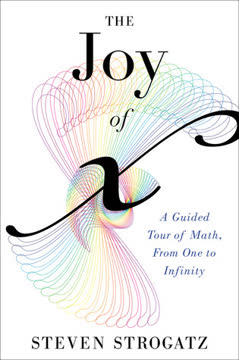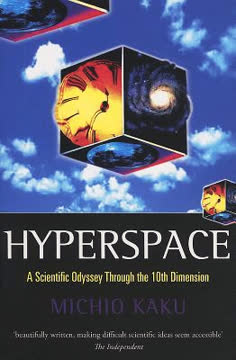Key Takeaways
1. Six numbers shape our universe's fundamental structure
These six numbers constitute a 'recipe' for a universe. Moreover, the outcome is sensitive to their values: if any one of them were to be 'untuned', there would be no stars and no life.
Cosmic constants. The universe's structure and evolution are determined by six fundamental numbers:
- N (≈10^36): Ratio of electrical to gravitational forces between protons
- ε (0.007): Efficiency of nuclear fusion in stars
- Ω: Ratio of actual density to critical density in the universe
- λ: Strength of cosmic 'antigravity'
- Q (≈10^-5): Amplitude of primordial density fluctuations
- D (3): Number of spatial dimensions
These numbers are precisely tuned to allow for the existence of complex structures like galaxies, stars, and life. Even small changes in their values would result in a drastically different, likely inhospitable universe.
2. The cosmos and microworld are intimately connected
There are deep connections between stars and atoms, between the cosmos and the microworld.
Scale interconnections. The universe exhibits remarkable connections across vastly different scales:
- Atomic nuclei and stellar cores both rely on nuclear fusion
- Quantum fluctuations in the early universe seed cosmic structures
- The weakness of gravity (N) allows for long-lived stars and complex structures
This interplay between the very small and the very large is crucial for understanding the universe's evolution and our place within it. It highlights the importance of studying both particle physics and cosmology to grasp the full picture of reality.
3. Stars forge the elements essential for life
The Earth, and we ourselves, are the ashes from those ancient stars.
Stellar alchemy. Stars are cosmic factories that create the elements necessary for life:
- Early universe: Only hydrogen, helium, and traces of lithium
- Stellar fusion: Creates heavier elements up to iron
- Supernovae: Forge elements heavier than iron
This process of stellar nucleosynthesis is responsible for the chemical diversity we observe in the universe. Our bodies and planet are literally made from the remnants of long-dead stars, connecting us intimately to the cosmic cycle of matter.
4. Dark matter dominates the universe's mass
The things that shine - galaxies, stars and glowing gas clouds - are a small and atypical fraction of what is actually there, rather as the most conspicuous things in our terrestrial sky are cloud patterns, which are actually insubstantial vapours floating in the much denser clear air.
Invisible influence. Dark matter, though unseen, plays a crucial role in the universe:
- Makes up about 25% of the universe's mass-energy content
- Visible matter accounts for only about 5% of the total
- Holds galaxies and galaxy clusters together
- Essential for the formation of cosmic structures
The nature of dark matter remains one of the biggest mysteries in modern physics. Its existence is inferred from its gravitational effects, but its composition is unknown, highlighting the limits of our current understanding of the universe.
5. The universe's expansion is finely tuned for complexity
Only a universe with a 'finely tuned' expansion rate can provide the arena for these processes to unfold.
Cosmic balance. The universe's expansion rate is crucial for the development of complex structures:
- Too fast: No galaxies or stars would form
- Too slow: Universe would collapse before life could emerge
- Just right: Allows for the formation of galaxies, stars, and planets
This apparent fine-tuning is quantified by the cosmic number Ω, which measures the balance between the universe's expansion and gravitational pull. The fact that Ω is close to 1 after billions of years of expansion is a cosmic coincidence that enables our existence.
6. Cosmic 'ripples' seed the formation of galaxies
Microscopic 'vibrations', imprinted when our universe was smaller than a golfball, inflate so much that they now stretch across the universe, constituting the ripples that develop into galaxies and clusters of galaxies.
Structure formation. The universe's large-scale structure originates from quantum fluctuations:
- Tiny density variations in the early universe
- Amplified by cosmic inflation
- Gravity enhances these fluctuations over time
- Result in the formation of galaxies and galaxy clusters
The amplitude of these initial fluctuations is described by the cosmic number Q. Its value of about 10^-5 is crucial for allowing structure formation without creating a universe dominated by black holes.
7. Our universe may be part of a vast multiverse
Separate universes may have cooled down differently, ending up governed by different laws and defined by different numbers.
Cosmic plurality. The multiverse concept offers a new perspective on cosmic fine-tuning:
- Multiple universes with different physical laws and constants
- Our universe: One of many possible configurations
- Explains apparent fine-tuning without need for a designer
- Predictions from theories like eternal inflation and string theory
While speculative, the multiverse idea provides a framework for understanding the seemingly improbable nature of our universe's parameters. It suggests that our universe's habitability is a selection effect rather than a fundamental feature of reality.
8. Extra dimensions could explain fundamental forces
In superstring theory, each 'point' in our ordinary space is a complicated geometrical structure in six dimensions, wrapped up on the scale of the Planck length.
Hidden complexity. String theory proposes extra spatial dimensions:
- Total of 10 or 11 dimensions
- 6 or 7 dimensions "curled up" at microscopic scales
- Could explain the nature of fundamental particles and forces
- Different ways of compactifying extra dimensions might lead to different universes
While currently untestable, these ideas offer a potential path to unifying quantum mechanics and gravity, addressing one of the most significant challenges in modern physics.
9. Time's arrow and the universe's expansion are linked
The asymmetry in time may be linked to the expansion of the universe.
Temporal directionality. The arrow of time is intimately connected to cosmic evolution:
- Expansion allows for increasing entropy and complexity
- Early universe: Near equilibrium due to high density and temperature
- Later stages: Departures from equilibrium enable structure formation
This connection between time's direction and cosmic expansion provides a potential explanation for the fundamental asymmetry we observe between past and future, linking thermodynamics with cosmology.
10. The apparent fine-tuning of cosmic constants raises profound questions
I'm impressed by a metaphor given by the Canadian philosopher John Leslie. Suppose you are facing a firing squad. Fifty marksmen take aim, but they all miss. If they hadn't all missed, you wouldn't have survived to ponder the matter. But you wouldn't just leave it at that - you'd still be baffled, and would seek some further reason for your good fortune.
Cosmic coincidences. The precise values of cosmic constants prompt deep philosophical questions:
- Anthropic principle: We observe these values because they allow our existence
- Design argument: Fine-tuning as evidence for a cosmic creator
- Multiverse: Our universe as one of many, with different laws and constants
These interpretations highlight the intersection of physics, philosophy, and cosmology. The apparent fine-tuning of the universe remains one of the most intriguing and contentious issues in modern science, challenging our understanding of the nature of reality and our place within it.
Last updated:
FAQ
What's "Just Six Numbers: The Deep Forces That Shape the Universe" about?
- Exploration of Six Numbers: The book explores six fundamental numbers that shape the universe, each representing a different aspect of cosmic structure and evolution.
- Cosmic Forces and Laws: It delves into the forces and laws that govern the universe, from the smallest particles to the largest galaxies.
- Interconnection of Scales: The narrative connects the microworld of particles with the macroworld of galaxies, illustrating how these numbers influence both.
- Author's Perspective: Martin J. Rees provides a non-technical explanation of these concepts, making them accessible to general readers interested in cosmology.
Why should I read "Just Six Numbers"?
- Understanding the Universe: It offers insights into the fundamental forces and numbers that govern the universe, enhancing your understanding of cosmology.
- Accessible Science: The book is written for general readers, avoiding technical jargon while explaining complex scientific ideas.
- Philosophical Implications: It raises philosophical questions about the nature of the universe and our place within it, encouraging deeper reflection.
- Author's Expertise: Martin J. Rees is a renowned cosmologist, providing authoritative insights into the subject matter.
What are the key takeaways of "Just Six Numbers"?
- Six Crucial Numbers: The book identifies six numbers that are crucial for the universe's structure and evolution, each with specific roles.
- Fine-Tuning of the Universe: It discusses the precise tuning of these numbers, which allows for the existence of stars, galaxies, and life.
- Interplay of Forces: The narrative highlights the interplay between different cosmic forces and how they shape the universe.
- Speculative Ideas: It introduces speculative ideas like the multiverse, offering a broader perspective on cosmic possibilities.
What are the best quotes from "Just Six Numbers" and what do they mean?
- "Mathematical laws underpin the fabric of our universe": This quote emphasizes the fundamental role of mathematics in describing the universe's structure.
- "Our emergence and survival depend on very special 'tuning' of the cosmos": It highlights the delicate balance required for life to exist in the universe.
- "The universe covers a vast range of scales": This reflects the book's exploration of the universe from the smallest particles to the largest cosmic structures.
- "Is this tuning just a brute fact, a coincidence? Or is it the providence of a benign Creator?": This quote raises philosophical questions about the nature of the universe and its origins.
What are the six numbers discussed in "Just Six Numbers"?
- N (Gravity's Weakness): Measures the strength of gravity compared to electrical forces, crucial for the formation of stars and galaxies.
- E (Nuclear Efficiency): Determines how efficiently hydrogen fuses into helium, affecting star lifetimes and element formation.
- Q (Cosmic Texture): Represents the initial density fluctuations in the universe, influencing the formation of galaxies and clusters.
- D (Spatial Dimensions): Refers to the number of spatial dimensions, which is three in our universe, affecting the stability of orbits and structures.
- Lambda (Cosmic Repulsion): Describes the energy density of empty space, influencing the universe's expansion rate.
- Omega (Density Parameter): Measures the total matter density of the universe, determining its ultimate fate (expansion or collapse).
How does Martin J. Rees explain the concept of fine-tuning in the universe?
- Precise Values Required: Rees explains that the six numbers must have precise values for the universe to support complex structures and life.
- Cosmic Balance: The book discusses how slight variations in these numbers could lead to a lifeless or radically different universe.
- Philosophical Implications: It raises questions about whether this fine-tuning is coincidental, a result of a multiverse, or indicative of a creator.
- Scientific Exploration: Rees uses scientific evidence and theories to explore the implications of this fine-tuning on our understanding of the universe.
What is the significance of the number N in "Just Six Numbers"?
- Gravity's Weakness: N measures the weakness of gravity compared to electrical forces, which is crucial for the formation of large structures like stars and galaxies.
- Impact on Evolution: A smaller N would result in a universe with smaller, short-lived stars, hindering the development of complex life.
- Cosmic Scale: The large value of N allows for a universe with vast scales and long timespans, essential for cosmic evolution.
- Role in Structure Formation: N's value influences the balance between gravitational forces and other forces, affecting the stability of cosmic structures.
How does "Just Six Numbers" address the concept of the multiverse?
- Speculative Idea: The book introduces the multiverse as a speculative idea where multiple universes exist, each with different physical laws and constants.
- Explaining Fine-Tuning: The multiverse concept offers a potential explanation for the fine-tuning of the six numbers, suggesting our universe is one of many where conditions allow for life.
- Scientific Basis: Rees discusses how current theories, like inflation, support the possibility of a multiverse, though it remains unobservable.
- Philosophical Implications: The multiverse raises questions about the nature of reality and our place within a potentially infinite ensemble of universes.
What role does the number E play in the universe according to "Just Six Numbers"?
- Nuclear Fusion Efficiency: E determines the efficiency of nuclear fusion in stars, affecting their lifetimes and the synthesis of elements.
- Star Lifetimes: A different value of E would alter how long stars can shine, impacting the development of life-supporting environments.
- Element Formation: E influences the production of elements like carbon and oxygen, essential for life, during stellar evolution.
- Cosmic Energy Source: The energy released by nuclear fusion, governed by E, powers stars and drives the processes that shape galaxies.
How does Martin J. Rees explain the number Q in "Just Six Numbers"?
- Cosmic Texture: Q represents the initial density fluctuations in the universe, which are crucial for the formation of galaxies and large-scale structures.
- Impact on Structure Formation: A smaller Q would result in a universe with fewer and less massive galaxies, while a larger Q would lead to a more chaotic universe.
- Role in Cosmic Evolution: Q's value determines the balance between smoothness and clumpiness in the universe, affecting the development of cosmic structures.
- Observational Evidence: Rees discusses how measurements of the cosmic microwave background radiation provide evidence for the value of Q.
What is the significance of the number Lambda in "Just Six Numbers"?
- Cosmic Repulsion: Lambda describes the energy density of empty space, which can cause the universe's expansion to accelerate.
- Impact on Expansion: A non-zero Lambda suggests that the universe's expansion is accelerating, influencing its ultimate fate.
- Role in Cosmic Balance: Lambda's value affects the balance between gravitational attraction and cosmic repulsion, determining the universe's large-scale structure.
- Scientific Debate: Rees discusses the ongoing scientific debate about the value of Lambda and its implications for cosmology.
Review Summary
Just Six Numbers explores six cosmological constants that shape our universe. Rees argues these numbers are finely tuned to allow life, sparking debates about design vs. chance. Readers found the book informative but sometimes dry or outdated. Many appreciated Rees's clear explanations of complex concepts, though some criticized his treatment of fine-tuning arguments. The book touches on topics like dark matter, cosmic expansion, and the anthropic principle, providing a concise introduction to modern cosmology for general audiences.
Similar Books







Download PDF
Download EPUB
.epub digital book format is ideal for reading ebooks on phones, tablets, and e-readers.




